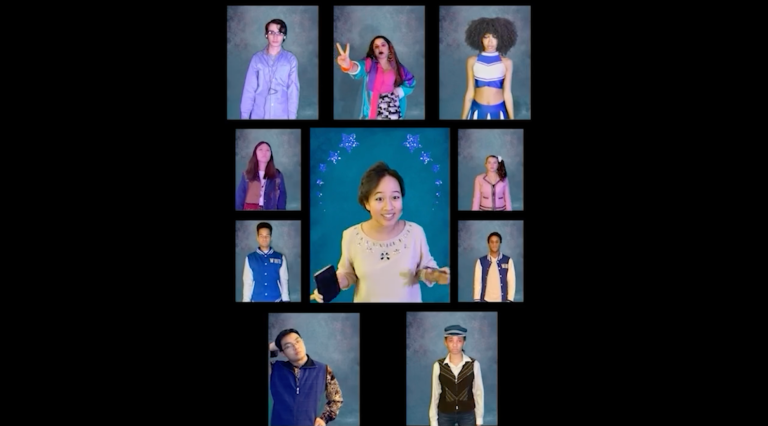Ram’s Head Theatrical Society’s “Heathers” isn’t your average Zoom musical.
Granted, the term “average Zoom musical” is a bit of an oxymoron. Theater, after all, was not designed for a video conferencing platform; it is meant to be enjoyed live and in-person — a communal experience in which actors and audiences briefly enter a new world.
But although the cast of “Heathers” sang from their separate dorm rooms and childhood bedrooms, and audience members watched from their laptop screens, Sunday night’s performance found a way to recreate that transformative theatrical magic.
The show follows high school senior Veronica Sawyer (an astonishing Junah Jang ’24) as she joins a clique of the titular Heathers (Maliha Yousuf ’24, Tyah-Amoy Roberts ’23 and Isabella Juarez ’23 — all wonderfully confident and charismatic) and navigates the toxic masculinity of football jocks Ram Sweeney and Kurt Kelly (brought hilariously to life by Cainan Cole ’20 M.S. ’21 and Dylan Moore ’24). In the process, however, Veronica loses touch with her sweet friend Martha Dunnstock (a heartbreaking Lee’Shae Lawson ’23).
At the heart of “Heathers” lies Veronica’s relationship with Janie “J.D.” Dean (Emily Saletan ’24), the new kid who downs Slurpees and speaks with a philosophical air. In both the original musical and the 1989 film on which it is based, J.D. is Jason Dean. But when Saletan broached the possibility of auditioning for the part, directors Diana Khong ’22 and Gwen Phagnasay Le ’22 saw tremendous potential in a queer re-imagining of the production.
“We did a lot of initial tablework, which was sitting down with the script and examining the new dynamics of gender, presentation, and sexuality in the show,” Saletan wrote in a statement to The Daily. “Especially given the setting of 1980s Ohio, J.D. becomes even more of an outsider, and her relationship with Veronica becomes something the two of them cling to even more desperately.”
And the writers of “Heathers: The Musical” — Laurence O’Keefe and Kevin Murphy — fully supported Khong and Le’s vision, scripting an all-new, official gender-bent version.
“We got the updated script and on the front page it said ‘Female J.D. Rewrite for Stanford,’” Saletan recalled. “I was like, that’s me! I’m the female J.D. at Stanford!”

Indeed, a female J.D. changes everything. Though it may be sacrilegious to say, I’ve never been a fan of the original movie — it has an undercurrent of apathy that leaves me feeling cold and distant from its characters, especially Christian Slater’s smarmy J.D. But, in Ram’s Head’s production, Saletan threw herself so fully into the role that I could not help but feel compassion for her character. Saletan’s J.D. is the victim of her classmates’ homophobic violence, of a father who wishes for “a real boy.” When she proposes killing the queen bees and alpha males and staging their deaths as suicides, I at least knew where she was coming from.
Here, Veronica and J.D. are reminiscent of “Euphoria”’s Rue and Jules — a co-dependency you know is toxic but root for anyway. Not to mention, Jang and Saletan have incredible chemistry, and I had to keep reminding myself that they weren’t sharing the same space.
“We act directionally, so when I’m in a scene with someone, I look away from my screen to the left or right,” Saletan explained. “To the audience, it gives the effect that we’re looking at each other, but in reality, we’re both talking to a wall.”
This is just one of the many challenges to virtual theater. As a Zoom actor, “you work as your own technician operating lights and sound, turning off your video while remaining in character,” Saletan wrote. “There are so many more things for each individual person to keep track of.”
But none of these obstacles was apparent on Sunday. Instead, the “Heathers” team’s ingenuity shone through: rich orchestrations, vibrant costuming, hard-hitting choreography, clever camera angles and a jaw-droppingly beautiful set — all tailored for a digital arena. I can’t even begin to imagine the work that went into creating such stunning visuals … I still struggle to share my screen during class presentations.
In Saletan’s view, “nothing virtual — auditions, rehearsals, performances — compares to inhabiting the same space.”
But as “Heathers” came to a close, I found myself hopeful about the future of the Zoom musical. Even as the performing arts return to in-person venues, I am excited to see how this technological era will drive theater to further innovation.
